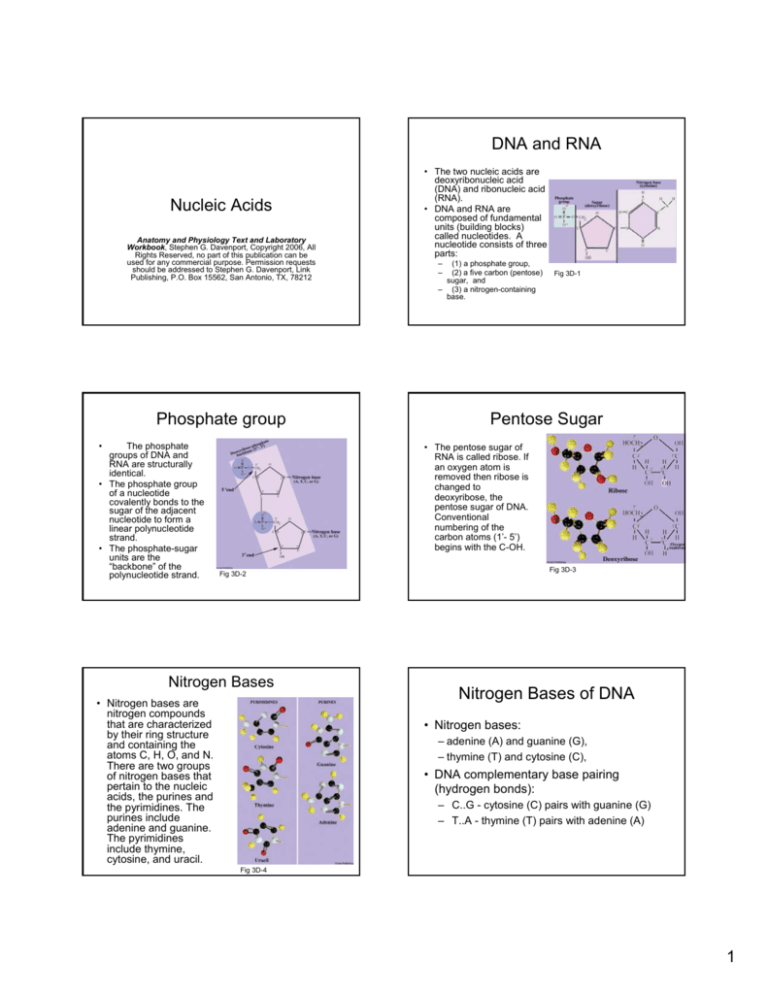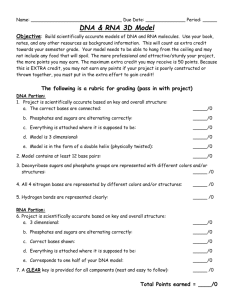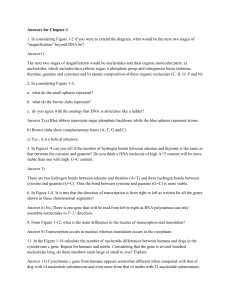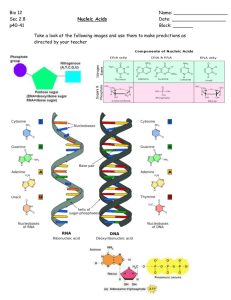
DNA and RNA
Nucleic Acids
Anatomy and Physiology Text and Laboratory
Workbook, Stephen G. Davenport, Copyright 2006, All
Rights Reserved, no part of this publication can be
used for any commercial purpose. Permission requests
should be addressed to Stephen G. Davenport, Link
Publishing, P.O. Box 15562, San Antonio, TX, 78212
Phosphate group
•
The phosphate
groups of DNA and
RNA are structurally
identical.
• The phosphate group
of a nucleotide
covalently bonds to the
sugar of the adjacent
nucleotide to form a
linear polynucleotide
strand.
• The phosphate-sugar
units are the
“backbone” of the
polynucleotide strand.
• The two nucleic acids are
deoxyribonucleic acid
(DNA) and ribonucleic acid
(RNA).
• DNA and RNA are
composed of fundamental
units (building blocks)
called nucleotides. A
nucleotide consists of three
parts:
–
–
(1) a phosphate group,
(2) a five carbon (pentose)
sugar, and
– (3) a nitrogen-containing
base.
Fig 3D-1
Pentose Sugar
• The pentose sugar of
RNA is called ribose. If
an oxygen atom is
removed then ribose is
changed to
deoxyribose, the
pentose sugar of DNA.
Conventional
numbering of the
carbon atoms (1’- 5’)
begins with the C-OH.
Fig 3D-3
Fig 3D-2
Nitrogen Bases
• Nitrogen bases are
nitrogen compounds
that are characterized
by their ring structure
and containing the
atoms C, H, O, and N.
There are two groups
of nitrogen bases that
pertain to the nucleic
acids, the purines and
the pyrimidines. The
purines include
adenine and guanine.
The pyrimidines
include thymine,
cytosine, and uracil.
Nitrogen Bases of DNA
• Nitrogen bases:
– adenine (A) and guanine (G),
– thymine (T) and cytosine (C),
• DNA complementary base pairing
(hydrogen bonds):
– C..G - cytosine (C) pairs with guanine (G)
– T..A - thymine (T) pairs with adenine (A)
Fig 3D-4
1
Nitrogen Bases of RNA
•
Nitrogen bases:
– adenine (A) and guanine (G),
– uracil (U) and cytosine (C),
•
DEOXYRIBONUCLEIC ACID
- DNA
RNA complementary base pairing
(hydrogen bonds):
– C..G - cytosine (C) pairs with guanine (G)
– U..A - uracil (U) pairs with adenine (A)
Chromosome
Chromosomes are the
most complex
organizational form of
DNA and consist of
supercoiled molecular
DNA and its associated
proteins (histones).
– In the human, the
chromosome number for
a somatic (body) cell is
46 (23 pairs).
Chromosomes are
observed in cells which
are in cell division
(mitosis and meiosis).
Chromatin
•
Chromatin is the dark stained DNA
dispersed in the nucleus of non-dividing
cells (interphase). Chromatin consists
mostly of molecular DNA and associated
proteins called histones.
Fig 3D-9
Molecular DNA
• Molecular DNA
•
Molecular DNA is the
simplest structural form of
DNA. In this form the genetic
code is accessible and is
used for
– (1) self-replication (cell
division) and
– (2) transcription. Transcription
is the process of using the
DNA as the template for the
assembly of the ribonucleic
acids (RNAs).
Fig 3D-10
Molecule of DNA
• A molecule of DNA consists of
two polynucleotide strands that
are organized into a double
helix.
• Each polynucleotide strand is
formed by the bonding of the
phosphate group of one
nucleotide to the sugar
(deoxyribose) of the adjacent
nucleotide.
• Each sugar is also covalently
boned to a nitrogen base that
extends toward the center of
the helix.
• Each nitrogen base is
hydrogen bonded to its
complimentary nitrogen base
(extending from the other
polynucleotide strand).
Fig 3D-11
2
Structure of DNA
• Nucleotides
•
The building blocks of molecular DNA are
nucleotides. A DNA nucleotide is formed from three
components: (1) a phosphate group, (2) deoxyribose (a
pentose sugar), and (3) one of four nitrogen bases adenine (A), thymine (T), cytosine (C), or guanine (G).
Since there are four nitrogen bases, there are four
different nucleotides.
RIBONUCLEIC ACID - RNA
Fig 3D-12
Structure of RNA
Nucleotides
•
Ribonucleic acid consists of fundamental structural
units (building blocks) called nucleotides. The nucleotide
structure of RNA consists of three fundamental parts: (1)
a phosphate group, (2) ribose (a pentose sugar), and (3)
one of four nitrogen bases, adenine (A), uracil (U),
cytosine (C), or guanine (G).
Function of RNAs
• The ribonucleic acids (RNAs) function in
the process of protein synthesis
(translation) as three structural and
functional types:
– messenger RNA, mRNA,
– ribosomal RNA, rRNA, and
– transfer RNA, tRNA.
Fig 3D-12
Messenger RNA (mRNA)
•
Messenger RNA consists of a single
strand of nucleotides. It is assembled in
the nucleus from a template of DNA, a
gene, a process called transcription.
• Messenger RNA carries the genetic
information from the DNA (transcription
occurs in the nucleus) into the cytoplasm
of the cell.
Fig 3D-24
Fig 3D-23
3
Ribosomal RNA (rRNA)
• Ribosomal RNA (rRNA) and proteins are
used in the construction of ribosomes, the
sites where translation occurs. A
ribosome consists of a large and a small
subunit.
Transfer RNA (tRNA)
• Transfer RNA (tRNA) is a highly folded molecule
consisting mostly of RNA nucleotides. The folds of the
molecule are produced by complementary base pairing
of the RNA nucleotides. During translation, transfer RNA
functions in the transfer of amino acids to mRNA
Fig 3D-25
Fig 3D-26
• Each transfer RNA molecule has two functional
sites; one site functions as the binding site for an
amino acid and the other site, a region of three
exposed nitrogen bases called an anticodon,
recognizes (binds to) its appropriate code word
(codon) of messenger RNA.
Fig 3D-27
4








